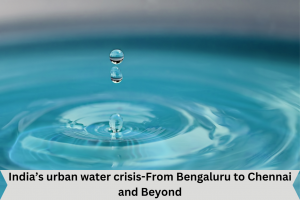ForumIAS announcing GS Foundation Program for UPSC CSE 2025-26 from 19 April. Click Here for more information.
ForumIAS Answer Writing Focus Group (AWFG) for Mains 2024 commencing from 24th June 2024. The Entrance Test for the program will be held on 28th April 2024 at 9 AM. To know more about the program visit: https://forumias.com/blog/awfg2024
Source-This post on India’s urban water crisis-From Bengaluru to Chennai and beyond has been created based on the article “How to fix India’s urban water crisis, from Bengaluru to Chennai and beyond” published in “The Indian Express” on 28 March 2024.
UPSC Syllabus-GS Paper 1- Urbanization, their problems and their remedies. India’s urban water crisis-From Bengaluru to Chennai and beyond
Context– Bengaluru is experiencing its worst water crisis in decades. The weak monsoon last year has compounded an already difficult situation. Along with Bengaluru, several other Indian cities are under similar stress.
As per the Pey Jal Survekshan, only 10 % of Indian cities meet drinking water standards. This indicates that water supply is not considered during urban planning.
What are the reasons for deterioration of water quality in the distribution network?
1) Compounds from old pipes may get released into the water.
2) There is buildup of sediment and the accumulation of pathogens.
3) Due to sewer lines close to leaky pipes in many Indian cities, there is deterioration of water quality.
Read more- Bengaluru water crisis
What are the problems with the water distribution network in Indian cities?
1) Faulty piped water supply approach-As per the standards of the Central Public Health and Environmental Engineering Organization, Indian cities have a daily per capita water requirement of 135 liters.
Under the current piped water supply approach, all this water is treated to meet drinking water quality standards. However, a person requires only a fraction of this amount for drinking and cooking purposes. So, this practice of treating large quantities of water to drinking water quality standards and distributing is not beneficial.
2) Capital intensive– The distribution network of water supply is quite costly. Further, there are regular expenses on repair and maintenance.
What steps can be taken to address this issue?
1) Reforming piped water supply approach – There is a need to segregate water for drinking purposes and other domestic uses. This will ensure that only a small amount of wastewater is treated for drinking water quality standards.
2) Packaged drinking water (PDW) model-It relies on decentralized treatment of water and non-pipe mode of delivery. According to a recent study, 38 % of households in Kolkata and 70 % of households in Chennai routinely purchase water jars despite having access to piped water.
However, a large section of urban population cannot buy water sold by private players. Further, as per WHO, the reverse osmosis method used by industry to purify water deprives water of essential minerals. Thus, these problems should be addressed before its widespread implementation.
3) Water ATMs-It is a water dispensation system which can be automatic with a coin or smart card, or manually. The recent water crisis in Bengaluru has pushed the city’s authorities to experiment with water ATMs.
There is a need for an alternative model of water supply to address the water quality issues. Steps such as Decentralized treatment and non-pipe mode of service delivery should be promoted by the government.
Question for practice
What are the problems with the water distribution network in Indian cities? Suggest measures to overcome the problem.





